
Armenian is an Indo-European language and the sole member of the independent branch of the Armernian language family. It is the native language of the Armenian people and the official language of Armenia. Historically spoken in the Armenian highlands, today Armenian is also widely spoken throughout the Armenian diaspora. Armenian is written in its own writing system, the Armenian alphabet, introduced in 405 AD by Saint Mesrop Mashtots. The estimated number of Armenian speakers worldwide is between five and seven million.
A thesaurus, sometimes called a synonym dictionary or dictionary of synonyms, is a reference work which arranges words by their meanings, sometimes as a hierarchy of broader and narrower terms, sometimes simply as lists of synonyms and antonyms. They are often used by writers to help find the best word to express an idea:
...to find the word, or words, by which [an] idea may be most fitly and aptly expressed

Aram Ilyich Khachaturian was a Soviet Armenian composer and conductor. He is considered one of the leading Soviet composers.

Andranik Nahapeti Margaryan served as the Prime Minister of Armenia from 12 May 2000, when the President appointed him, until his death on 25 March 2007. He was a member of the Republican Party of Armenia. He succeeded the Sargsyan brothers: Vazgen Sargsyan, who was murdered during the Armenian parliament shooting on 27 October 1999 and Aram Sargsyan, whom the President appointed a week later, but fired on 2 May 2000.
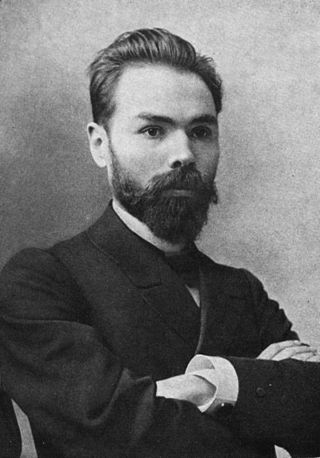
Valery Yakovlevich Bryusov was a Russian poet, prose writer, dramatist, translator, critic and historian. He was one of the principal members of the Russian Symbolist movement.

The culture of Armenia encompasses many elements that are based on the geography, literature, architecture, dance, and music of the Armenian people. Armenia is a majority Christian country in the Caucasus.

Yerevan Brusov State University of Languages and Social Sciences, is a public university in Yerevan, the capital of Armenia, operating since 1935. It is named after the Russian poet and historian Valery Bryusov since 1962.
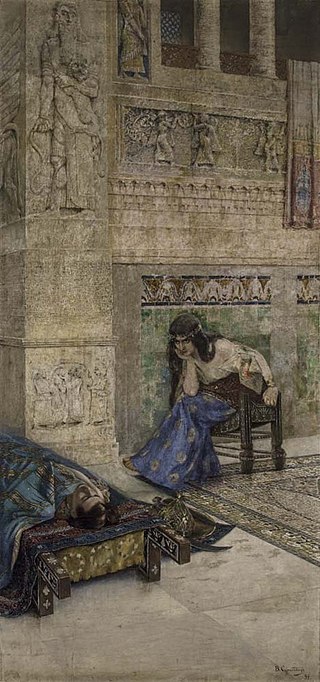
Ara the Handsome is a legendary Armenian hero and king. He is the son of the legendary king Aram and a descendant of the Armenian patriarch Hayk. Scholars believe that Ara, Aram and Hayk were originally deities who were later reinterpreted as legendary human heroes. Ara represented a dying-and-rising agricultural god and is thought to have embodied fertility within the Indo-European triad of sovereignty, war, and fertility, along with Hayk and Aram. Ara is the subject of a popular legend in which the Assyrian queen Semiramis, desiring the handsome Armenian king, wages war against Armenia to capture him and bring him back to her, alive. Ara is killed in the war, and Semiramis attempts to bring him back to life.

Hrachia Acharian was an Armenian linguist, lexicographer, etymologist, and philologist.

Stepanos Sargsi Malkhasiants was an Armenian academician, philologist, linguist, and lexicographer. An expert in classical Armenian literature, Malkhasiants wrote the critical editions and translated the works of many classical Armenian historians into modern Armenian and contributed seventy years of his life to the advancement of the study of the Armenian language.

Kentron, is one of the 12 districts of Yerevan, the capital of Armenia. It comprises the downtown, the commercial centre of the city. As of the 2011 census, the district has a population of 125,453.
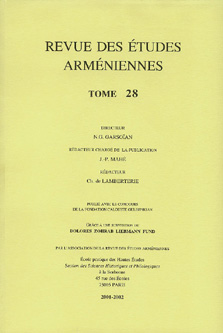
Revue des Études Arméniennes is a peer-reviewed academic journal that publishes articles relating to Classical and medieval Armenian history, art history, philology, linguistics, and literature. The Revue was established in 1920 at the initiative of French scholars Frédéric Macler and Antoine Meillet. Meillet himself wrote many of the articles during the formative years of the journal (1920–1933), which typically covered Armenian history, grammar, and folk tales, including the modern period. The Revue was not published from 1934 to 1963.
Aram Ter-Ghevondyan was an Armenian historian and scholar who specialized in the study of historical sources and medieval Armenia's relations with the Islamic world and Oriental studies. His seminal work, The Arab Emirates in Bagratuni Armenia, is an important study on the Bagratuni Kingdom of Armenia. From 1981 until his death, Ter-Ghevondyan headed the Institute of Oriental Studies at the Armenian Academy of Sciences and he additionally held an honorary doctorate from the University of Aleppo and was an associate member of the Tiberian Academy of Rome.
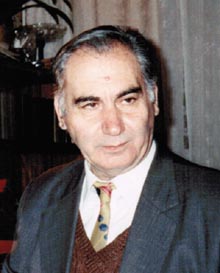
Nikoghos Tahmizian was an Armenian musicologist, theorist and historian. His professional accomplishments were to decipher neumes (khaz) of Armenian church music, analyze the musical theory of old Armenia and research the life and works of Armenian composers from medieval times to modern era.
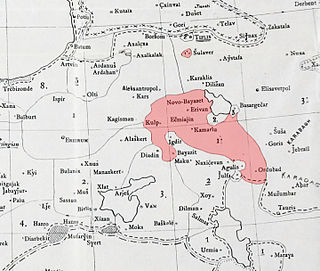
The Yerevan dialect is an Eastern Armenian dialect spoken in and around Yerevan. It served as the basis for modern Eastern Armenian, one of the two standardized forms of Modern Armenian. Classical Armenian words, as well as native Armenian words which are not attested in Classical Armenian, compose a significant part of the Yerevan dialect's vocabulary. Throughout history, the dialect has been influenced by several languages, especially Russian and Persian, and loan words have significant presence in it today. It is the most widespread Armenian dialect today.
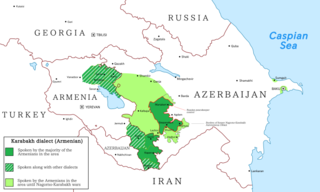
The Karabakh dialect, also known as Artsakh dialect is an ancient Eastern Armenian dialect with a unique phonetic and syntactic structure mainly spoken in the Azerbaijani region of Nagorno-Karabakh and partially in the southern and northeastern parts of the Republic of Armenia, i.e. in the provinces of Artsakh, Utik, Syunik and Gugark of historical Armenia.
Alishan Avedis Bairamian was an Armenian-American intellectual, linguist, historian, and author. Born in 1914 in Kilis, a part of historic Armenian Cilicia, he was a survivor of the Armenian genocide.

Aram Karamanoukian was a Lieutenant General of the Syrian Army. He was also a member of the Syrian Parliament. He is the author of several books. For his work as a scholar and military serviceman, Karamanoukian received medals from Egypt, Armenia, Lebanon, Syria, and France.

Hranush Tovmasyan is an Armenian linguist and translator.















